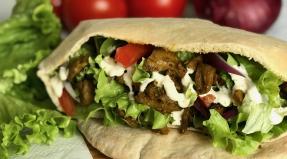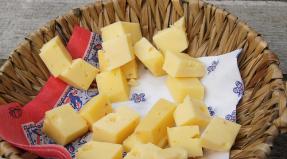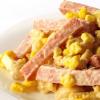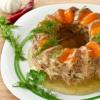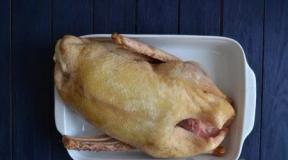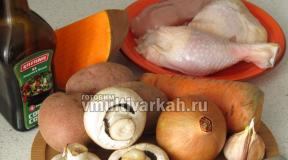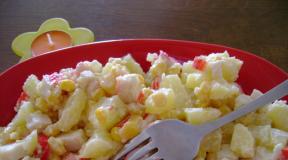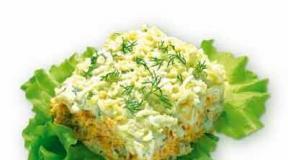Russian sausages: how do they differ and how to choose a quality meat product on the counter? Three rules for choosing a good sausage.
Likbez for the buyer.
We are still the most reading country. True, we used to read on public transport, but now more and more in stores…when we buy sausage or bread. But only for dedicated consumers, the label is a guide, for the majority it is a real puzzle. Three simple rules will help you figure out the composition of your favorite sausages, choose the most natural.
Rule number one - read as it is written
Some manufacturers try to hide what is hidden. Or confuse. Therefore, they often do not write anything plainly on the label. Allocate only the name of the product and the price. Or they write the “composition” in such a way that you can’t make out without a magnifying glass.
All this is done in the expectation that the buyer from the shelves where the packaged sausages are, goes to the counter, where everyone is released "cut into". After all, it seems that sausage from under the knife is fresher and tastier.
We asked Dmitry Kozlov, director of production at the Meat House of Borodin, to reveal the secrets of trade to our readers.
- It's self-deception. Products that are on the shelves already packaged and packed in sealed plastic packages, and those that are sold cut, are the same. And the view of the cut is more pink only thanks to special lighting. Today, manufacturers bring sausages to stores in two forms. Whole loaves, which are cut right in front of you, or already packaged at the enterprise and packed in a vacuum casing. But they are all the same. Sausage packaged at the enterprise can always be recognized by a thermocheck. This is a sticker that indicates the weight, price, date of packaging, expiration date, storage conditions, barcode, GOST or TU and, of course, the composition of the product. If it shows the coordinates and logo of the manufacturer, and not the seller, then be sure that this is his branded packaging. For example, for the convenience of customers, we made a branded thermal label, on which the most important information is highlighted in color, printed in large print, and even highlighted in color.”
Rule number two - read the composition by name
If the composition of the product is written crookedly, palely, some words are illegible or jammed on the folds, this is already a reason to doubt the quality. Product information, especially about something as delicate as sausage, should always be exhaustive. The one who guarantees quality has nothing to hide.
In the composition of the product, all ingredients are listed in a certain order: as their weight decreases in the recipe. Therefore, meat components should go in the sausage at the very beginning - pork, beef, bacon. There should be most of them, this is the basis of the sausage, giving it taste, aroma and color. But it’s bad if all sorts of meat substitutes are added to them. In addition to soy (often listed as a vegetable protein) and carrageenan, it can also be gums and starch - they also bind water and save on meat.
But recently, very often use not vegetable, but animal protein. It would seem that what is wrong with him, he is an animal, and therefore full-fledged? In fact, it is a tasteless and odorless powder, usually made from recycled connective tissue (veins, cartilage, skin). This cheap component, which is dissolved in water and added to the sausage, is, in fact, a meat substitute. There is no taste from it, like from soy. Therefore, in such sausages there is usually a flavor enhancer glutamate.
It is difficult to do without it if another innovation is used in the sausage - poultry meat. The so-called MMO (mechanically separated meat) is usually used. This is a cheap stuffing type raw material. It is obtained by grinding either the whole bird or carcasses with the remnants of meat. Then fragments of the smallest ground bones are separated from the resulting mass. But, of course, some of them remain. In addition to meat and "bones", bone marrow, connective tissue and poultry skin enter the MMO.
“Natural sausage should be made from meat: pork and beef,” Dmitry Kozlov explains. - It should contain water, salt, spices. The composition of the doctoral also includes milk and eggs. This is the ABC of natural taste. All other components are guests from the periodic table. Desirable and not so desirable. They are discussed below.
Rule number three - no soy, carrageenan and flavor enhancers
Soy and carrageenan bind a large amount of water and thus displace a decent proportion of the meat from the sausage. To make such an economical product edible, you need a flavor enhancer - monosodium glutamate, without it, the sausage looks more like rubber - there is not enough meat in it.
But that's not all the buyer needs to know. Manufacturers come up with various tricks to give the impression that their product is natural. But in reality, it is completely different. Therefore, let's take a closer look at some of the rules for reading sausage labels.
If you meet a "complex food additive" in the composition of the sausage, be sure that this is not the best product. Indeed, in addition to natural spices, it will certainly contain food chemistry - fillers, thickeners, flavor enhancers. By law, the composition of any complex additive must be deciphered. But in practice, not everyone does this. Sometimes they write simply - a complex food supplement such and such (in their names they often beat well-known sausages - doctoral, amateur, salami, servelat, etc.), without disclosing its composition. This is a violation of the law. Since it is practically impossible to find a complex additive without food chemistry, then, having found it in the composition, put the sausage back and try to find something more natural - without glutamate, carrageenan, starch and gums. Today it is possible.
Perhaps you did not immediately remember everything that we told you. Don't worry, experience comes with time. The main thing you need to pay attention to first of all is the flavor enhancer (aka monosodium glutamate - E621). Its presence indicates that something is wrong with the sausage. The following options and their combinations are possible. First, low-quality meat was used in the production of sausages. Second: they saved on meat and did not put it enough. Third: the sausage contains meat substitutes, fillers, thickeners, water and a bunch of food additives. Fourth, and this is the most common reason for using monosodium glutamate: a combination of all three of these options together. Remember, sausage made from good meat does not need a flavor enhancer, its taste is the taste of the meat itself. And whoever stops saving on meat, he really makes a revolution in the sausage business.
Sausage for our man, whatever you say, is a cult product. After all, it was she who replaced the meat of hazel grouse in the famous salad of the chef Olivier. It is she who invariably flaunts on the so-called "meat plates". Refrigerators littered with sausages have been associated with prosperity since Soviet times. It is not surprising that sausage, despite the protests of ardent supporters of an absolutely healthy diet, ranks fourth in the ranking of food products that are in constant demand among the population, second only to dairy products, bakery products and potatoes.
First name - Sausage, and last name? Choosing sausages: meat or meat-containing
In meat products, in fact, the meat component is large, truly the lion's share - more than 60% (these are boiled sausages of the highest grade, raw smoked sausages and salami). Meat-containing sausages are meat-and-vegetable (when meat is from 60% to 30% - it’s just as lucky), vegetable-meat (meat is at least 5% here ... but, as a rule, not more) or analogues of meat products (almost without meat, but with its aroma and taste, "to what progress has come"). So pay attention to the "surname" of your sausage.Vegetarian sausage?
You can find soy as herbal supplements in non-premium sausages. It will not harm your body. Please note: if the soy is genetically modified, you will definitely find the inscription on the sausage "The product contains GMOs (GMI)". By the way, in the Republic of Belarus it is forbidden to use GMI in baby food. Soy is a “very tricky thing”: it is introduced into the composition to increase the yield of finished products (soy protein retains water in the sausage). Sometimes cereals and beans are also added to meat-containing sausage. This does not make the sausage less useful, but it does make it less meaty.
What will be in your mouth: sausage according to GOST or TU?
When the composition of the sausage is developed by the manufacturer, it is considered that it complies with the TU (technical specifications). They, in contrast to the GOSTs (state standards) adopted by the state, each manufacturer can come up with on their own, but with a safety check and coordination with the State Sanitary Inspection. One of the indirect signs that the sausage was made not according to GOST, but according to TU, is the name. For example, such a sausage will no longer be called "Doctor's" (in accordance with GOST), but with some prefix, say, "Doctor's Suite".What's inside a boiled sausage?
It is even easier to deal with the composition of sausage than with the composition of cosmetics: the ingredients here are also arranged “in descending order”. For example, the composition of sausages of the highest grade of the Belarusian manufacturer: pork, pork fat (i.e. lard), milk, melange (i.e. frozen egg mass), salt, food additive. Or here is another composition: pork, beef, pork fat, raw beef fat, milk, eggs, salt, food additive. Accordingly, these products contain the most pork and the least food additives. Thank God it's not the other way around :)We choose "dumpling" on the shell
If you plan to take sausages for only one meal, then it is better to choose natural casings. But if you take the product “in reserve”, then the choice should be made in favor of artificial vapor-gas-permeable casings: they allow you to increase the shelf life up to 20-30 days (but this is only if the sausage loaf is not cut). Be aware that poultry fats are less resistant to oxidation, so eat sausage with such a component almost “moment”.Maybe there was a raid on the sausage?
White coating on raw smoked expensive sausages is not at all a sign of spoilage; on the contrary, it is a source of antimicrobial substances. Before using such a sausage, in no case do not wash it with water, but simply wipe it with vegetable oil.Sorting
Dear experts, attention, a question: what are the white veins in sausage (for example, in salami)?
This is connective tissue. In premium sausage, the amount of such tissue is minimal; but the lower the grade, the greater its share in the composition of the product. Unsorted sausage has the lowest nutritional value.

Hit List of Food Supplements
It is allowed to add a food additive to sausages that accelerates the maturation of sausages; sodium nitrite to preserve bright color; the notorious monosodium glutamate to enhance the taste and aroma, etc. Special bacteria can be added to salami, which also accelerate the ripening of sausages. Be that as it may, all food additives must be included in the list of permitted for use in Belarus and not exceed the permissible levels. The latter, alas, is extremely difficult for the consumer to check when buying.Why goat button accordion, and phosphates - sausage?
Phosphates (E450-452) are real hard workers: they retain moisture in sausages, stabilize color and improve texture. In fresh meat (immediately after slaughter, especially in the meat of young gobies), the moisture-binding ability of the protein is at an optimal level - sausage and without phosphates, you get "you will lick your fingers." But, unfortunately, thawed meat of cows and pigs is more often used to make sausages. It has a lower moisture absorption, as a result of which the sausage made from such meat, without a moisture-binding agent, may turn out to be watery and tasteless. To prevent this unpleasant phenomenon, it is necessary to add a small (!) amount of phosphates.Phosphates can be included in all sausages in an amount not exceeding 400 mg per 100 g of product. They are also “useful” in that when they are added, the mass loss of the product during cooking decreases, the yield of finished sausage increases (a tricky economic benefit); in addition, the sausage acquires the stability of properties during storage. Phosphates, binding water, make sausages more juicy, uniform, beautiful, without bouillon-fat edema.
However, everything is good in moderation! Due to the excessive concentration of phosphates, the protein dissolves, and when cooking the sausage, the minced meat becomes loose. Therefore, if the sausage is loose rather than tightly rolled into a loaf, it may be a high phosphate litmus test. At the same time, the nutritional value of the product decreases: there is less protein in the sausage, and more water, thanks to phosphates.

Do "sausage" phosphates harm us?
If sausage is on your table every day, there will be a fact of excessive intake of phosphates in the body. As a result, the absorption of calcium is impaired and the available calcium is washed out of the bones. The following symptoms will help to suspect hypocalcemia (i.e., a decrease in the calcium content in the body) in practically healthy people: general weakness, increased fatigue, dry skin, brittle nails and hair, progressive dental diseases (caries and periodontitis), paresthesia (goosebumps run on the skin) and muscle twitching (for example, cramping of the toes), in children - a violation of posture and growth retardation. Such people often have fractures, as they say, "out of the blue." Probably, the hero of the "Diamond Hand" abused sausages.In addition, an excess of phosphate leads to the formation of stones in the kidneys and gallbladder, complicates the work of the liver and gastrointestinal tract, there is a predisposition to anemia (since there is a connection between the exchange of phosphorus and iron in the body) and the risk of calcium deposition in vessels and tissues.

Decrease brightness
We have all seen how red meat turns gray-pink when cooked. So why do boiled sausages stay bright pink and some even raspberry? The fact is that the addition of sodium nitrite and ascorbic acid, as it were, "fixes" the bright color of the sausage. In concentrations permitted for use on the territory of Belarus (up to 0.005 mg per 100 g), sodium nitrite solution does not adversely affect health.However, when eating sausages, be aware that an “overdose” of sodium nitrite can cause cancer. By the way, ascorbic acid in this case will be a useful antagonist (therefore, it is important to see the presence of E 250 + E 300 in the recipe). Also, the possible harm from sodium nitrite is neutralized by adding vegetables to a sausage sandwich: lettuce, tomatoes, peppers.

What else?
Starch is good in jelly, but not in sausage: there should be no starch in the sausage of the highest grade. To check the integrity of the manufacturer, you can conduct an iodine test at home, familiar from the time of studying school chemistry. Grind a piece of sausage and drop iodine - in the presence of starch, you will see sausage "blue". You can also cut off a thin slice of sausage and roll it into a tube: if there is little or no starch at all, the slice will not break.Dieters should take into account that boiled sausages contain a fairly high percentage of animal fats. Try an experiment: put a piece of boiled (without fat inclusions) sausage in a hot frying pan without oil and see how much fat is rendered from this piece. The same applies to sausages. Raw-smoked or dry-cured sausage is “more honest” in this regard: the amount of bacon is immediately visible there.
Also, when choosing boiled sausage in a store, pay attention that there are no large voids on the cut, because the reason for this may be, on the one hand, a technological defect, and on the other hand, the possible reproduction of botulism sticks (because it comes with mandatory education gases, a cavity is formed). By the way, translated from Latin botulus (“botulus”) - sausage.
Is it possible for everyone, does everyone need it?

We are what we eat. Eating habits are formed from childhood. Therefore, it is not worth buying sausages every day to feed your home. Sausages are high in salt, saturated fat and cholesterol; sausages have an irritating effect on the digestive tract and urinary system. Especially their consumption should be limited to those who suffer from arterial hypertension, overweight, gout, gastrointestinal diseases, urolithiasis and cardiac disorders.
What kind of sausage is better to buy for children?
It’s better not to give sausages to children under three years old at all, older children should choose boiled sausages and sausages recommended for baby food (they usually have funny names: “Totoshka”, “Tigers”, etc.). Beforehand, they must be boiled in water without a plastic shell (or placed without water for several minutes in a microwave oven in a sealed container). Excess fat, as well as salt and sodium nitrite, will sink into oblivion, that is, they will go into the water.
Of the more expensive sausages, as a not very frequent delicacy, a child can be given a small piece of dry-cured sausage. However, this is a product that is indigestible for the children's stomach, and should not replace the main meal. It is better not to give raw smoked sausage to children, since during the smoking process, substances that are unfavorable for the body are formed, which are not unreasonably attributed to carcinogenic properties. By the way, since September 1, 2010, raw smoked sausage has been on the list of prohibited foods for school canteens in Belarus.

What do we have, how do we store it?
It turns out that the terms and conditions of storage of sausages depend on the composition of the food additive and the type of casing. All these data must be indicated on the label. Boiled sausages, sausages and sausages are perishable products: their temperature is from 0 to 6 degrees, the period is on average from 2 to 5 days. Although, we recall, some manufacturers (thanks to special artificial casings) declare a shelf life of up to 30 days (with an uncut loaf and in the refrigerator).The lower the grade of sausage, the shorter its shelf life. Half-smoked sausages (not packed in a film under vacuum) are stored from the moment of production in the refrigerator for no more than 12 days, and if it is sliced - no more than 10 days. Raw smoked and dry-cured sausages are a product of longer storage (up to 3-4 months). The drier the sausage, the longer it will keep. Therefore, when choosing such a sausage, do not hesitate to "test the ground" and "put pressure on the patient." Press the sausage with your fingers: if it is firm and does not leave finger impressions, then the sausage is well dried.
"Sausage" to health!
Please rate this article by choosing the desired number of stars
Site readers rating: 4.3 out of 5(24 ratings )
Noticed an error? Select the text with the error and press Ctrl+Enter. Thank you for your help!
Section Articles
 January 14, 2018 Now in the world there is a boom of "superfoods" - hyper-healthy food, a pinch of which can cover almost the daily norm of the nutrients the body needs. The editors of the portal site decided to conduct their own study of the popularity and usefulness of chia, including the real experience of readers of the portal and Facebook friends, including Maria Sanfirova, the author of this review and part-time vegetarian with decent experience ...
January 14, 2018 Now in the world there is a boom of "superfoods" - hyper-healthy food, a pinch of which can cover almost the daily norm of the nutrients the body needs. The editors of the portal site decided to conduct their own study of the popularity and usefulness of chia, including the real experience of readers of the portal and Facebook friends, including Maria Sanfirova, the author of this review and part-time vegetarian with decent experience ...
 January 09, 2018 The first mention of miraculous seeds dates back to 2600 BC. BC. Chia, along with maize, which, by the way, was treated as a deity, affectionately magnifying "our flesh, our treasure", and amaranth - "the golden grain of the gods", constituted the main diet of the Maya and Aztecs - exceptionally hardy peoples with a beautiful bodily constitution and good health...
January 09, 2018 The first mention of miraculous seeds dates back to 2600 BC. BC. Chia, along with maize, which, by the way, was treated as a deity, affectionately magnifying "our flesh, our treasure", and amaranth - "the golden grain of the gods", constituted the main diet of the Maya and Aztecs - exceptionally hardy peoples with a beautiful bodily constitution and good health...
02 June 2017 Whatever happens, don't stop drinking! I mean, whether it's sweltering heat outside or cool as London skies, always drink plenty of fluids. Of course, in the heat we drink much more actively: our body is “afraid” to overheat and therefore cools down by evaporation of sweat, while losing not only water, but also mineral salts and water-soluble vitamins ...
As part of a rolling study of Roskachestvo, according to 70 indicators of quality and safety, 40 brands of Doktorskaya sausage were studied, 30 of which went for testing in 2017, and 10 in 2018. The sample included the most popular federal and regional brands among Russians . All of it was produced in Russia (in Belgorod, Vladimir, Vologda, Leningrad, Moscow, Pskov, Saratov, Tver regions, the Republic of Mordovia, Stavropol Territory, as well as in Moscow and St. Petersburg; now sausage from Amur, Kemerovo, Sverdlovsk, Tomsk, Chelyabinsk regions, the Republic of Mari El and the Krasnodar and Perm regions). Today, the study includes products from 20 subjects of the Russian Federation. The cost of sausage weighing from 320 to 1310 grams ranged from 90 to 499 rubles. According to the results, Doctor's sausage of nine brands meets the requirements of current quality and safety standards, as well as the requirements of the leading Roskachestvo standard. The State Quality Mark has already been assigned to the sausage "Okraina" and "Tomarovsky Meat Processing Plant". Also, Doctorskaya under the trademarks Agrocomplex, Balakhonovsky Meat Processing Plant, Myasnov, Pit-Product (LLC Pit-Product), Romkor, Snezhana and Family sausages."
RUSSIAN QUALITY SYSTEM STANDARD
The test program for sausage "Doctor" included the indicators of GOST R 52196-2011 "Cooked sausage products. Specifications". Roskachestvo also examined the product for the presence of foreign DNA. According to the standard of the Russian quality system, Doctorskaya sausage, which claims to be a Quality Mark, must not contain starch, preservatives (benzoic and sorbic acids) and dyes: E102, E110, E124, E131, E132, as well as antibiotics even in trace amounts.
The study of "Doctor's" sausage has become one of the most popular among the citizens of our country. After its publication, consumers from different regions of the country began to actively write to the portal, social networks and the Roskachestvo mobile application with a request to explore sausages of other brands: federal and regional, large and local. Of course, we could not leave these letters unanswered. Therefore, we decided to make the study regular and supplement it with the results of testing new brands by Doctorskaya.
Sausage: sterile product
Is what we eat safe? With regard to the "Doctor's" this issue is particularly acute. This is evidenced by the number of publications about the quality of "folk" sausage and the desire of consumers to see this particular study on the Roskachestvo portal. We will not torment the Doctor's lovers for a long time. All studied sausage "Doctor" is safe. It did not reveal violations of microbiological parameters. It also does not contain heavy metals, radionuclides and genetically modified ingredients (GMI).
In particular, this indicates that production control was not violated at the enterprises and sanitary and hygienic requirements were observed. According to the test results, the sausage is produced under sterile conditions.
Doctor's sausage was named so because it was intended for "sick people who undermined their health as a result of the Civil War and tsarist despotism." It was developed by employees of the Mikoyan plant by order of the People's Commissariat of Health. Initially, in the 30s of the last century, this sausage included beef, pork, eggs, salt and milk. The recipe was unchanged until 1974 - then they decided to add a little starch and flour to the Doctor's. Now in a sausage made according to GOST, let's say sodium nitrite and spices, and in a sausage made according to TU - flavors, antioxidants, flavor and aroma enhancers.
Doctor's antibiotics
Animal products again – and antibiotics again (see studies broiler chickens). This time they were found in products of 17 brands, that is, in almost half of the products studied. Recall that the presence of antibiotics is associated with their residual content in meat, which is used for the manufacture of meat products.
Although it is worth mentioning that in the sausage of 16 brands there was no excess of the norms, but trace amounts were found, indicating non-compliance with the terms of pre-slaughter aging or concentration. Manufacturers of these products are not violators, but their products are deprived of the opportunity to qualify for the Russian Quality Mark.
But one manufacturer violated the mandatory requirements established by law. In branded sausage "Provincial Meat Company" the amount of an antibiotic of the tetracycline group is 1.5 times higher than the maximum allowable level.
For comparison: in sausages "Dairy" TM "Provincial Meat Company" in the corresponding study, no excesses in antibiotics were recorded. The reason for this instability is the imperfection of veterinary control (it is impossible to control the content of antibiotics in each carcass).
In turn, in the sausage "Doctor" under the TM "Vladimir Standard" and "Rublevsky" trace amounts of antibiotics are noted, which are allowed in the product. It should be noted that the sausages of these brands just contained antibiotics in quantities exceeding the norms of TR CU.
The situation is commented Maxim Sinelnikov, Deputy Chairman of the Executive Committee of the National Meat Association:
- In some of the studied product samples, traces of antibiotics were found at the level of error. On the one hand, this is a problem for manufacturers, who missed raw materials with residual traces of antibiotics during the control of incoming raw materials. On the other hand, this problem is related to the fact that antibiotic residues in slaughter products are not sufficiently controlled at slaughterhouses, insufficient control of feed for the content of antibiotics in them is carried out at livestock enterprises, or enterprises abuse antibiotics and use them in violation of recommendations for use.
– In this case, it is advisable for processors and raw material suppliers to establish deeper interaction to eliminate problems with raw materials. Already today, the meat industry is actively implementing electronic veterinary certification, which ensures traceability and allows the manufacturing enterprise to receive exclusively safe meat raw materials from suppliers. Mandatory electronic veterinary certification should come into force in 2018, and the implementation of traceability in enterprises cannot be delayed. In addition, there is a problem in the current regulation, namely in the regulation of the maximum allowable levels (MRLs) of antibiotics. For example, the MRL for tetracycline for finished meat products is 10 times more stringent than the MRL for meat raw materials. In other words, when meat raw materials at the input control meet the established requirements, at the same time, when controlling finished products - sausages and sausages containing 60-80% of meat ingredients - the MRL indicator may be exceeded. This problem has been repeatedly identified by the meat processing industry. To solve it, it will be necessary to make changes to the technical regulations and synchronize the MRL indicators.
Horse, soy, corn - what was found in the sausage?
What is sausage made from? This question worries consumers. Around the sausage, as well as around any other folk product, a lot of rumors are teeming. Therefore, the experts examined Doktorskaya for the presence of foreign genetic material (DNA of sheep, horses, dogs and cats, as well as corn and soybeans) and found out:
- In branded sausage "Novoaleksandrovsky Meat Processing Plant" found soy. The manufacturer did not consider it necessary to notify the buyer about this by marking. However, it is impossible to estimate the amount of soybeans - there is no methodology. There may have been a small amount of soy that got into the spice products.
- branded sausage Gorin Product contains corn. However, the quantities in which it is found do not allow us to know whether corn was added to the product intentionally or accidentally. Therefore, this fact is not considered a violation, but the products of this TM will not be able to qualify for the Russian Quality Mark.
- The situation is similar with trace amounts of horse DNA that were found in sausage. "Klinsky".
Read more about where “foreign” DNA comes from in meat products. .
In addition to excess genetic material, the experts looked to see if the sausage contained the declared meat. In particular, they looked for DNA from pigs and cattle. As a result, for the first time in our research, we did not find the declared beef at all in the supposedly pork and beef “Doctorskaya”! This is how the sausage manufacturer deceived consumers "Yola"(Mari El). In fairness, it should be noted that the Yola sausage is one of the cheapest sausages that took part in the study. Its purchase price amounted to 190.08 rubles. for one kilogram.
Despite this, experts have identified many positive and even debunking popular myths facts:
- In most of the studied sausage, the experts found exactly those DNAs that correspond to the meat declared in the composition (pigs or cows). And in principle, despite the fact that there are some additional ingredients in the composition, the DNA of a pig and a cow is recorded in the sausage of 39 out of 40 brands. Sausage is actually made from meat.
- Of the 40 brands, only one product contains soybeans. Thus, the myth about the widespread use of soy was not confirmed.
- Cellulose was not found in any sample - there is no paper in the composition of Doctor's!
- And the absolutely terrible myth about the use of cat and dog meat in the production of sausages was smashed to smithereens. The DNA of our pets was not found in any of the examined samples.
Our expert comments Maxim Sinelnikov:
– The study showed that there is a problem of the so-called trace effect. This is when an in-depth analysis reveals ingredients not declared by the manufacturer on the label. Existing research methods have a very high sensitivity at the DNA level. These methods only say that there is a detection, but how much of the undeclared ingredient as a percentage of the product was found, such methods cannot say. It cannot be unequivocally said that the manufacturer is the violator, since, for example, carrageenan or starch could get into the products unintentionally. For example, when using a complex food additive or spice that contained an undeclared ingredient, its traces, that is, hundredths or thousandths of a percent, were identified during the study. The legislation does not set thresholds for such cases, which automatically makes any manufacturer of processed products an infringer. This problem needs to be addressed in two ways. First, it is necessary to develop methods that allow you to determine the amount of the undeclared ingredient. Secondly, it is necessary to establish in the legislation a requirement for the mandatory indication of all ingredients on the label if their quantity exceeds the established threshold. Such a mechanism is now implemented for cases where the manufacturer did not use GMOs in the production of food products, but traces of GMOs may be contained. In this case, the content of 0.9% or less of GMOs in food products is an accidental or technically irremovable impurity, and such products do not apply to food products containing GMOs. The detection in the course of a laboratory study of an ingredient not declared on the label in an amount below the threshold value will mean the absence of a violation. After changing the legislation, it will be possible to unambiguously say which manufacturer has fulfilled the requirement in good faith, and which one deliberately misleads the consumer, which is a falsification and a serious violation of the law.
I agree with Maxim Sinelnikov Ekaterina Luchkina, executive director of the National Union of Meat Processors:
- Let's think together: a manufacturer whose products are 95% pure meat (!), Plus milk, eggs, salt, spices, who values his name and reputation, will he put some fractions of a percent of soybeans to damage his image? Of course not! But at present, the regulatory framework does not imply a clear distinction between trace values and the actual presence of one or another type of raw material in the product. To analyze the species composition of products, a qualitative method is used (the result is “yes / no” or “found / not found”), and not a quantitative method (if found, how much?), The sensitivity of the method is extremely high, almost two molecules are enough to determine the presence ( qualitative method - found). The National Union of Meat Processors considers it essential to legally regulate this issue.
For details on when it is unprofitable for manufacturers to falsify sausage, read.
chicken question
According to the recommendations of GOST R 52196-2011, Doctor's sausage should be made from ground pork and beef. There should be no chicken meat in it. However, it is cheaper, and, as previously shown research sausages "Dairy", some manufacturers use it.
So, in "Doctor" under the trademarks "Egorievskaya" And "Tsaritsyno", made in accordance with GOST, chicken meat was found. In the sausage "Egorievskaya" - mechanically deboned poultry meat (fragments of bone, cartilage, muscle tissue), in the sausage "Tsaritsyno" - meat and fragments of the skin of a bird. Moreover, both manufacturers did not indicate poultry meat in the composition on the labeling. By doing this, they violated the rights of consumers to reliable labeling. Information about the violation was sent to the control and supervisory authorities.
Poultry meat has also been found in some other brands of sausage. But, firstly, the manufacturers made their product according to their own standards (TU), and secondly, they indicated the presence of chicken on the packaging of goods. Therefore, these manufacturers are not violators. At the same time, they will not be able to claim the Russian Quality Mark, since they used an ingredient in the manufacture that is not recommended by GOST.
Among the sausages made according to specifications, we will single out the product under the TM "Starodvorskie sausages". In addition to chicken breast fillets, animal protein is indicated in the composition. What is it - opened the analysis for histology. The composition of the “Doctor’s” “Starodvorskie sausages” includes directly animal protein, as well as particles of bones and cartilage, bird skin and fragments of the heart. Apparently, all this is also hidden under the phrase "animal protein". As mentioned above, the product is manufactured according to specifications, therefore it is not officially a violator. That is, we are talking not only about the presence of chicken meat in the composition of the sausage, but also about the content of offal and mechanically deboned meat in the sausage.
In the sausage TM "Atyashevo" (made from pork and beef mince), the experts found parts of the heads, particles of mucous membranes and cartilage. By the way, fragments of bones and cartilage were also found by experts in Atyashevo TM sausages. Only then it was also a bird (the manufacturer makes Atyashevo sausage from minced pork and beef). In both cases, the manufacturer did not indicate the presence of bones, cartilage, etc. on the label.
What else is added to the sausage?
Carrageenan
Carrageenan is used to obtain the necessary consistency of minced meat, when there is not enough functional protein in it itself. It forms the texture of the product. GOST does not allow the presence of carrageenan at all. Well, in any case, the ingredient must be indicated on the label. However, manufacturers of twelve brands added carrageenan to the sausage, but did not put it on the label. This "JSC "Cherepovets Meat Processing Plant", "Near Hills", "Velcom", "Vyazanka", Gorin Product, "Dmitrogorsk product", "Yola", "Kuzbass Food Processing Plant", "Mikoyan", "Meat house of Borodin 1997", "Cherkashin and partner" And "Cherkizovo". These manufacturers have violated consumer rights to fair labeling. The supervisory authorities have been notified of this.
Starch
Some manufacturers may use starch to improve the consistency of minced meat, its "gluing". In principle, it is acceptable in a product manufactured in accordance with GOST. True, with a mandatory indication on the labeling. However, the Roskachestvo standard does not allow the use of starch for applicants for the Quality Mark. Producers of branded sausages told about the presence of starch "Vyazanka" And "Starodvorskie sausages". On the label "Doctor" TM "Vologda Meat Processing Plant" starch is not specified, however, experts found a starch-containing component here. The amounts found indicate that it is most likely that it got into the product with spices. Finally, the sausage maker Gorin Product did not report the presence of starch on the label.
preservatives
The current legislation does not regulate the presence of preservatives in sausages. However, the TR TS "Safety Requirements for Food Additives, Flavorings and Processing Aids" contains a clause that sorbic and benzoic acids are not allowed in meat products for children. With a sandwich from Doctor's, parents often "equip" their children for school. Therefore, Roskachestvo experts examined the sausage for the presence of preservatives. However, benzoic and sorbic acids were not found in it. By the way, about the product for which benzoic acid is mandatory, read .
Phosphates
Phosphates are stabilizers necessary in the manufacture of sausages. In increased quantities, they can have a negative effect on the body. However, there were no excesses in the amount of phosphates in the investigated sausage.
sodium nitrite
Also, there were no excesses in the content of sodium nitrite, which is mandatory for sausages (preservative and color fixer). Read why Doctor's is pink and how much you need to eat it to harm the body.
Cellulose
Fiber is another moisture-retaining component. It can be used by manufacturers to increase product yield, reduce weight loss during heat treatment, improve structure, etc. Its presence in Doctorskaya is not prohibited by law, but the presence of fiber must be included in the label. This was not taken into account by sausage manufacturers "Yola", "Pig complex "Tomsky" And "Green Village": there is no fiber in the labeling of these products, but in fact there is.
"Traditional" underweight
And again the problem of underweight. No, no, yes, and there is at least one manufacturer that deceives the buyer and sells him some air. As the results of the study showed, the producer of the Doktorskaya sausage under the trade mark "Velcom". According to the test results, the underweight was almost 17%: a loaf of Velkom sausage weighs 416.4 instead of 500 grams. Such fraud is a violation of consumer rights.
Taste
As in other studies, an important place was taken by the organoleptic evaluation of the "Doctor". This examination was carried out, among other things, by certified organoleptics from FBU "Test - St. Petersburg" in the laboratory.
As the study showed, the most delicious sausage is not always the most natural. The same thing happened with Dairy sausages. And since the main thing is naturalness, the organoleptic assessment is given only for reference. Readers can see how professionals rated the taste of Doctorskaya and compare it with their own. Is there your favorite sausage here?
* The organoleptic evaluation was carried out by certified organoleptics in the laboratory.
33 types of boiled-smoked and semi-smoked sausages of popular brands were purchased and sent for examination. Almost all purchased samples are positioned as made in accordance with GOST. Products labeled in this way inspire consumer confidence, but are high quality requirements actually met?
The study involved sausages "Moskovskaya", "Krakowskaya", "Odesskaya", "Servelat", "Sudzhuk", produced under the brands "Velkom", "Dymov", "Ostankino", "Eremkina T. P.", "Myasnov ”, “Setun”, “Mikoyan”, “Cherkizovsky”, “Butcher's Row”, “Remit”, “Reserved Products”, “Metatr”, “Near Hills”, “Malakhovsky”, “Naro-Fominsk Meat Processing Plant”, “Egorievskaya sausage and gastronomic factory named after K. Yu. Afanasyev”, “Bakhrushin”, “Ramen”, “AMK”, “Ecole”, “Mortadel”, “Rublevsky”, “Outskirts”, “Snezhana”, “Klinskiy Meat Processing Plant”.
Semi-smoked sausages in the manufacturing process after roasting and boiling are subjected to additional hot smoking and drying. The current standard for semi-smoked sausages isGOST 31785-2012.
Boiled-smoked sausages in the manufacturing process after the first smoking and cooking are subjected to a second smoking. The current standard for cooked smoked sausages is GOST R 55455-2013.
Most sausages are made according to GOST. Six out of 33 are made according to TU, but their names are very similar to well-known trademarks, so we compared their composition with GOST.
The examination was carried out according to the test program, including histological analysis and determination of a whole range of physicochemical and microbiological indicators of quality, safety and nutritional value of the samples. If facts of falsification were revealed, further testing of the samples was not carried out.
The results are not encouraging. Violations were found in almost every sample. 25 sausages were recognized as counterfeit, other violations were found in 7 more.
What's inside? Starch and paper!
According to the results of histological examination, cheap substitutes for beef and pork (soy and collagen protein, mechanically deboned poultry meat, animal skins), starch, cellulose, water-retaining agents (carrageenan) were found in 2/3 of the samples. These ingredients are not listed in the products. The products are counterfeit. These additives reduce the nutritional value of the product and reduce its cost. Moreover, most of them should not be in sausages made according to GOST at all.
Collagen, aka collagen protein, is a cheap meat substitute. It is obtained from tendons, bones, cartilage (waste from the processing of livestock raw materials). It is not uncommon for manufacturers to disguise collagen under the euphemism “animal protein” on the label. However, its biological value is very low.
Carrageenan is a moisture-retaining component that allows manufacturers to increase the weight of the product due to moisture, while reducing its cost. It literally allows producers to sell water for the price of meat.
Are these additives harmful to human health? " Collagen "animal" protein itself is completely harmless, but it does not contain the most important essential amino acids for humans.-methionine and tryptophan. The biological value of collagen is extremely low. In other words, it cannot provide us with all the "bricks" necessary to build the tissues of our body and synthesize the necessary enzymes. It is much cheaper than meat, and many manufacturers cannot resist the temptation to add it to sausages to save on production costs. However, the systematic consumption of products containing collagen protein is harmful, as it poses a threat of nutritional imbalance and even protein starvation,- tells Andrey Mosov, head of the expert direction of NP "Roskontrol", doctor. - Soya-it is a cheap alternative to meat, an absolutely adequate substitute for it in terms of nutritional value. Adequate in nutritional value, but not in price. Soy protein is several times cheaper than meat, so there is a consumer fraud here, which has primarily an economic background. And a violation of the rights of consumers who should know the actual composition of products».
How much protein is in a sausage?
Eleven samples, which with honor passed the histological examination, were checked by experts for protein content. Studies have shown that the mass fraction of protein is the most important indicator for meat products; in some cooked-smoked and semi-smoked sausages, it is much less than the lower limit established by GOST for this type of sausage. This content does not correspond to the information on the nutritional value indicated in the labeling.
The mass fraction of protein is below the minimum allowable for this type of sausage VALUES- in servlets of brands such as Snezhana, Borodin's Meat House and Rublevsky, and in Moskovskaya sausage from Outskirts.
Of course, this is, firstly, a fake - there is less meat in the sausage than stipulated by GOST - the manufacturer clearly saved money here. Secondly, the consumer, buying such a product, will receive less protein. These samples were also included in the "black list" of Roskontrol.
The highest protein content among all tested samples is in the Moskovia sausage from Myasnov - 18.75 g / 100 g. The sausage is made according to specifications, the composition corresponds to the one stated on the label and differs from the composition of the GOST sausage only in a large number of food additives .
Just add water!
The easiest way for a manufacturer to save money is to “pump” the sausage with water. Excess moisture, especially with moisture-retaining agents such as carrageenan and phosphates in the composition and a low protein content, clearly indicates falsification.
Too much water was found in the same sausages, in which studies revealed a lack of protein. At some samples have a moisture content that is one third higher than that allowed by the standard!
If the protein meets the standard, then excess moisture is most likely a sign of a technology violation. Such violations were recorded in sausages made in accordance with GOST: Moskovskaya from Ostankino (57%), Velkom (58%), Krakovskaya from Dymov (51%) and Eremkina T.P. (57%).
There is also excess moisture in the sausage produced according to TU, but with the name “Moscow Setun” similar to GOST from the Setun MPZ (56%).
In connection with moisture, it is worth mentioning such a moisture-retaining agent as phosphates. In some samples, according to experts, the content of phosphorus is slightly higher than its natural content. This suggests that manufacturers probably added phosphates not provided for by GOST, “forgetting” to reflect this fact in the labeling. In particular, in the samples of Borodin's Meat House and Snezhana cervelat, the content of phosphates exceeds the permitted amount.
There are also phosphates in the Setun sausage, the Servelat Kremlevskiy Mikoyan sausage, and the Muscovy sausage Myasnov, made according to the TU "Moscow" - however, their manufacturers honestly wrote about this in the labeling. At the same time, in the tested sample of Myasnov sausage, the content of phosphates slightly exceeded the allowable for products with added phosphates, which is why this sausage was included in the list of goods with comments.
The addition of phosphates saves on meat raw materials. However, phosphates, when taken with food in large quantities, can cause disturbances in phosphorus-calcium metabolism in humans.
GOST - a way to deceive the consumer ...
GOST marking, as well as other quality marks, is traditionally perceived as a kind of guarantee, inspires consumer confidence. Meanwhile, regular quality control has not been, and is not. Unscrupulous manufacturers manipulate this, and at the same time their products do not meet the declared standard.
According to the standards, in the composition of sausages made in accordance with GOST, natural meat should be used. It is not allowed to use: soy protein, poultry meat, carrageenan, gums, vegetable fiber, phosphates, emulsifiers and stabilizers, dyes, preservatives. In the composition of semi-smoked sausagesit is allowed to use animal proteins (including collagen protein), starch, wheat flour. However, information about them must be present on the label. Otherwise, it qualifies as fake.
In sausages according to specifications, all of the listed additives can be used, except for preservatives (they are allowed to be used only for surface treatment), but the manufacturer is obliged to inform the consumer about all additives in the labeling.
salt question
One of the most important physical and chemical indicators for the consumer is the salt content in the sausage. The standard is set by GOSTs. But manufacturers sometimes ignore the requirements of GOST, because salt is a cheap preservative that contributes to a longer and safer storage of sausages. In some sausages, there is so much salt that it is enough to eat only 70-80 grams of the product to cover the daily human need for sodium.
Ludmila Vevere
"Subbota" tasted five varieties of boiled sausage, which is sold in the country's supermarkets. The main conclusion: sausage is a combined meat-containing product, and not a piece of pork. That is, the Russian saying "The best sausage is meat" is right.
Sausage without E-additives: you have to get used to it!
A novelty on the market - Lithuanian sausage, which does not contain any E-additives, which is a great rarity for everyone who thinks about their health!
There is only one minus - the right sausage frankly loses to E-containing "colleagues" in the shop in taste. It's a shame, it's a shame, but it's a fact! After all, this sausage is really distinguished by its healthy content. But here's an opportunity - the tasters didn't like it too much ...
Which only says that over the past 20 years we have become unaccustomed to proper healthy food and addicted to food mixes stuffed with flavor enhancers, including monosodium glutamate (E621) - a common food additive designed to enhance taste sensations by increasing taste sensitivity. tongue receptors
Full fe-ching!
Monosodium glutamate is a white crystalline powder, highly soluble in water. In China it is known as "flavor seasoning", in Japan - as "wonderful powder" ("fe-jing"). The taste of glutamate is called "umami", which is one of the main taste sensations known to man.
Monosodium glutamate (E621) is obtained both from natural resources and through chemical reactions. Magic powder looks like salt or sugar. But his taste is different, in the West they say about him "savory" - a broth-like or meaty taste. In addition, this substance is able to enhance the taste of products made from meat, poultry, seafood, mushrooms, and some vegetables.
With frequent use of monosodium glutamate, a gradual loss of taste sensations is possible due to the gradual atrophy of taste buds. Recently, cases of allergy to monosodium glutamate in foods have become more frequent.
The substance adversely affects the retina of the eye and may contribute to visual impairment.
Monosodium glutamate today is simply not going anywhere (it is found in many products, especially sausages). In order not to accumulate a critical mass of this substance in the body, one should not overeat sausages, absorb them in kilograms - everything is good in moderation. A couple of sandwiches a day won't hurt for sure.
By the way, E-additives, starch, carageenans, soybeans are not the most dangerous in sausage. Much worse is meat squeezed out under pressure, where the bone mass and bone marrow of animals get - carcinogens live in them. Somewhere in New Zealand, bull bones will be put under pressure, and then this mixture will be added to Latvian products ... It happens. And this is much more unpleasant than food additives.
Pork skins with starch
Cheap sausages are, of course, but you need to understand that this is a complex mix not at all from meat, but, as a rule, from pork skins (or even emulsions from these same pork skins), soy, starch, some pea substances, semolina cereals and all kinds of chemicals.
Inexpensive sausage usually contains more or less soy protein, fat, starch, milk powder and nutritional supplements - permitted by the legislation of the Republic of Latvia. These are phosphates, which prevent the product from falling apart, and sodium nitrite, which gives the minced meat an appetizing pink color.
But stories about toilet paper in boiled sausage are nonsense! Besides, it makes absolutely no sense to do so. The fact is that modern technologies allow (in full compliance with the law of the Republic of Latvia!) the use of many inexpensive and harmless ingredients such as soy, cheap fat and food additives.
There are a lot of meat products on our market with the content of the main ingredient of 60, 50 and 45 percent.
We know very well how to make sausage so that it costs the buyer, say, lats per kilogram, - says Boris Kudryashov, head of the meat production. - But WHAT WILL THIS product be? Edible - yes. But is it useful?
One of the most inexpensive sausages is "Boiled" sausage (Variita desa), which is made in Lithuania on special order from RIMI.
Two pluses: firstly, the manufacturer honestly states that this is a second-class sausage. Secondly, all the ingredients of the mix are listed: no cheating!
Just when you eat such a sausage, do not expect any taste shocks. Ingredients: mechanically separated chicken meat - 29.6 percent, pork skin emulsion - 25.3 percent, water, chicken skin - 16.9 percent, semolina - 4.2 percent, potato starch - 2.5 percent, salt, spices , stabilizers E451, E452, thickener E412, aroma and flavor enhancer E621, sugar, flavourings, dye E120, preservative E250. As some say, the world's snack!
The price is appropriate - only 42 santims for 350 g. But to be honest, I don't understand why to spend money on such a product, when for the same 40 santims you can buy chicken wings and cook excellent soup? But this, as you understand, is my own vision of the topic. If cheap sausage is produced, it means that someone needs it. The energy value of this product: 148 kcal, proteins - 6 g, carbohydrates - 4 g, fats - 12 g.
Sausage legislation
As specialists from the Latsert certification center explained to us), the manufacturer is not obliged to indicate the percentage of pork or beef. Of course, this is not too correct in relation to the consumer, that is, to us. But! Many companies (apparently, who have nothing to hide) indicate how much meat is in their sausages. This, for example, is done by Rigas Miesnieks.
It seems to me that it is worth giving preference to sausages with clear contents.
Do not flatter yourself with inscriptions like "Products made from chilled meat" - this is most likely a publicity stunt. There is very little fresh meat, and even the best workshops are forced to work on frozen raw materials. By the way, Lido works exclusively on chilled meat.
Pay attention to the cut: the consistency should be even, without large voids and sagging. In terms of color, a weathered greyish cut that appears repulsive on the outside is actually sometimes better than a bright pink surface. A gray cut is an indicator that there are few dyes, preservatives and nitrite salt in the sausage.
starch test
You can try to determine if there is starch in the sausage if you ask the seller to cut off a thin slice and roll it into a tube. If there is no starch, then the slice will be elastic, it will easily curl up, it will not crack.
Expertise Leaders
Delicious boiled sausage with paprika, Lido
Composition: pork and beef meat, starch, paprika flakes, salt, spice extracts, stabilizer E450, flavor enhancer E621, antioxidant E-316, preservative E250.
The energy value: 276 kcal, proteins - 10.3 g, carbohydrates - 3 g, fats - 24.8 g.
Price: LVL 1.63 for 320 g.
Boiled sausage without E - Sausage, made in Lithuania by order of RIMI
Composition: pork meat - 72.6 percent, water, speck - 8.6 percent, salt, spices and their extracts, sugar, flavoring (this may be the only chemistry in this product).
The energy value: 219 kcal, proteins - 12 g, carbohydrates - 0.1 g, fats - 19 g.
Price: 90 centimes for 280 g.
To be honest, I'll try to get used to this sausage: maybe my dormant taste buds will someday come to life again? The product is definitely high quality and healthy.
Normal quality sausages
Desa ar sieru (sausage with cheese), Rigas Miesnieks
Very tender appetizing sausage with cheese. No forbidden food chemicals, which is also good.
Composition: mechanically separated chicken meat, water, pork skin, cheese - five percent, potato starch, soy proteins, vegetable proteins (pea flour), salt, stabilizer E450, glucose, antioxidant (ascorbic acid), spices (including celery, nutmeg), food coloring E120, preservative E250.
The energy value: 184 kcal, proteins - 13 g, carbohydrates - 6 g, fats - 12 g.
Price: 60 centimes for 400 g.
Sausage "Doctor's De Lukss", SIA Marno
Composition: beef and pork meat, water, pork fat, milk powder, egg powder, vegetable proteins, wheat fibers, salt, dextrose (same as glucose), spices, sodium nitrite preservative, ascorbic acid antioxidant, polyphosphate stabilizer, flavor enhancer monosodium glutamate, dye E120.
Price: 2.51 Ls per pound.
Tip 1: To be honest, sausage is actually a food pampering that we are used to without noticing it ourselves. It is much easier to cut off a piece of sausage and make a sandwich than to bake a piece of natural meat in the oven. If desired, even an inexperienced hostess can easily make a tender roll of beef or pork ... Tastier than any sausage, honestly. And much more useful.
Tip 2: Sausage is like a fly agaric - the brighter the color, the more dye! If the boiled sausage is too bright, it means that there are too many dyes in it. Sausages and wieners must have a smoked crust - otherwise they will fall apart during cooking.
Placement code for key after_article not found.
Placement code for key m_after_article not found.
